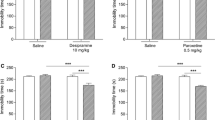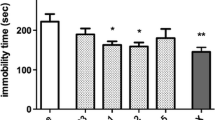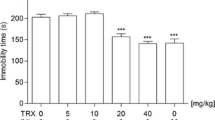Abstract
Rationale
Nociceptin/orphanin FQ (N/OFQ) is the endogenous ligand of a Gi protein-coupled receptor named NOP. Both N/OFQ and NOP receptor are widely expressed in brain areas involved in the control of emotional processes. Clinical and preclinical studies support antidepressant effects due to the blockade of NOP receptor signaling. By contrast, NOP receptor activation did not evoke any change in behavioral despair tests.
Objectives
The present study aimed to investigate the effects of the co-administration of NOP agonists and classic antidepressant drugs in the forced swimming test (FST) and learned helplessness model (LH) in mice.
Methods
Male Swiss mice were co-administered with NOP agonists (N/OFQ and Ro 65-6570) and antidepressants (nortriptyline, fluoxetine, and R-ketamine) or SB-612111 (NOP antagonist) and the behavioral effects were assessed in the FST and LH tests.
Results
Fluoxetine, nortriptyline, R-ketamine and the NOP antagonist SB-612111 displayed antidepressant-like effects in the FST. The administration of the NOP agonists N/OFQ and Ro 65-6570 did not induce any behavioral change. However, co-administration of NOP agonists blocked the antidepressant effects of SB-612111, fluoxetine, and nortriptyline, but not R-ketamine in the FST. Similarly, in the LH, the systemic injection of SB-612111, nortriptyline, and R-ketamine reversed helplessness. The co-administration of Ro 65-6570 blocked the antidepressant-like effects of SB-612111 and nortriptyline, but not R-ketamine.
Conclusions
NOP receptor activation inhibits the acute antidepressant effects of nortriptyline and fluoxetine, but not R-ketamine. The present findings contribute to further understand the role played by the N/OFQ-NOP receptor system in regulating mood states.




Similar content being viewed by others
References
Antony LJ, Paruchuri VN, Ramanan R (2014) Antidepressant effect of ketamine in sub anaesthetic doses in male albino mice. J Clin Diagn Res 8(6):HC05–HC07
Asth L, Ruzza C, Malfacini D, Medeiros I, Guerrini R, Zaveri NT, Gavioli EC, Calo' G (2016) Beta-arrestin 2 rather than G protein efficacy determines the anxiolytic-versus antidepressant-like effects of nociceptin/orphanin FQ receptor ligands. Neuropharmacol 105:434–442
Autry AE, Adachi M, Nosyreva E, Na ES, Los MF, Cheng PF, Kavalali ET, Monteggia LM (2011) NMDA receptor blockade at rest triggers rapid behavioural antidepressant responses. Nature 475(7354):91–95
Berman RM, Cappiello A, Anand A, Oren DA, Heninger GR, Charney DS, Krystal JH (2000) Antidepressant effects of ketamine in depressed patients. Biol Psychiatry 47(4):351–354
Boom A, Mollereau C, Meunier JC, Vassart G, Parmentier M, Vanderhaeghen JJ, Schiffmann SN (1999) Distribution of the nociceptin and nocistatin precursor transcript in the mouse central nervous system. Neuroscience 91(3):991–1007
Connor M, Vaughan CW, Chieng B, Christie MJ (1996) Nociceptin receptor coupling to a potassium conductance in rat locus coeruleus neurones in vitro. Br J Pharmacol 119(8):1614–1618
Cox BM, Chavkin C, Christie MJ, Civelli O, Evans C, Hamon MD et al (2000) Opioid receptors. In: Girdlestone D (ed) The IUPHAR compendium of receptor characterization and classification, 2nd edn. IUPHAR Media, London, pp 321–333
de Moura JC, Noroes MM, Rachetti Vde P, Soares BL, Preti D, Nassini R, Materazzi S, Marone IM, Minocci D, Geppetti P, Gavioli EC, André E (2014) The blockade of transient receptor potential ankirin 1 (TRPA1) signalling mediates antidepressant- and anxiolytic-like actions in mice. Br J Pharmacol 171(18):4289–4299
du Jardin KG, Liebenberg N, Cajina M, Müller HK, Elfving B, Sanchez C, Wegener G (2018) S-ketamine mediates its acute and sustained antidepressant-like activity through a 5-HT1B receptor dependent mechanism in a genetic rat model of depression. Front Pharmacol 8:978
Ferrari F, Malfacini D, Journigan BV, Bird MF, Trapella C, Guerrini R, Lambert DG, Calo' G, Zaveri NT (2017) In vitro pharmacological characterization of a novel unbiased NOP receptor-selective nonpeptide agonist AT-403. Pharmacol Res Perspect 5(4):1–17
Fukumoto K, Iijima M, Chaki S (2016) The antidepressant effects of an mGlu2/3 receptor antagonist and ketamine require AMPA receptor stimulation in the mPFC and subsequent activation of the 5-HT neurons in the DRN. Neuropsychopharmacology 41(4):1046–1056
Fukumoto K, Toki H, Iijima M, Hashihayata T, Yamaguchi JI, Hashimoto K, Chaki S (2017) Antidepressant potential of (R)-ketamine in rodent models: comparison with (S)-ketamine. J Pharmacol Exp Ther 361(1):9–16
Gavioli EC, Calo' G (2006) Antidepressant- and anxiolytic-like effects of nociceptin/orphanin FQ receptor ligands. Naunyn Schmiedeberg's Arch Pharmacol 372(5):319–330
Gavioli EC, Calo' G (2013) Nociceptin/orphanin FQ receptor antagonists as innovative antidepressant drugs. Pharmacol Ther 140(1):10–25
Gavioli EC, Marzola G, Guerrini R, Bertorelli R, Zucchini S, De Lima TC (2003) Blockade of nociceptin/orphanin FQ-NOP receptor signalling produces antidepressant-like effects: pharmacological and genetic evidences from the mouse forced swimming test. Eur J Neurosci 17(9):1987–1990
Gavioli EC, Vaughan CW, Marzola G, Guerrini R, Mitchell VA, Zucchini S (2004) Antidepressant-like effects of the nociceptin/orphanin FQ receptor antagonist UFP-101: new evidence from rats and mice. Naunyn Schmiedeberg's Arch Pharmacol 369(6):547–553
Gigliucci V, O'Dowd G, Casey S, Egan D, Gibney S, Harkin A (2013) Ketamine elicits sustained antidepressant-like activity via a serotonin-dependent mechanism. Psychopharmacology 228(1):157–166
Goeldner C, Spooren W, Wichmann J, Prinssen EP (2012) Further characterization of the prototypical nociceptin/orphanin FQ peptide receptor agonist Ro 64-6198 in rodent models of conflict anxiety and despair. Psychopharmacol (Berlin) 222(2):203–214
Green MK, Devine DP (2009) Nociceptin/orphanin FQ and NOP receptor gene regulation after acute or repeated social defeat stress. Neuropeptides 43(6):507–514
Hashiba E, Harrison C, Galo' G, Guerrini R, Rowbotham DJ, Smith G, Lambert DG (2001) Characterisation and comparison of novel ligands for the nociceptin/orphanin FQ receptor. Naunyn Schmiedeberg's Arch Pharmacol 363(1):28–33
Holanda VAD, Medeiros IU, Asth L, Guerrini R, Calo' G, Gavioli EC (2016) Antidepressant activity of nociceptin/orphanin FQ receptor antagonists in the mouse learned helplessness. Psychopharmacol (Berlin) 233(13):2525–2532
Kametani H, Nomura S, Shimizu J (1983) The reversal effect of antidepressants on the escape deficit induced by inescapable shock in rats. Psychopharmacol (Berlin) 80(3):206–208
Kilkenny C, Browne W, Cuthill IC, Emerson M, Altman DG (2010) Animal research: reporting in vivo experiments: the ARRIVE guidelines. Br J Pharmacol 160:1577–1579
Kos T, Legutko B, Danysz W, Samoriski G, Popik P (2006) Enhancement of antidepressant-like effects but not brain-derived neurotrophic factor mRNA expression by the novel N methyl-D-aspartate receptor antagonist neramexane in mice. J Pharmacol Exp Ther 318(323):1128–1136
Le Maître E, Dourmap N, Vilpoux C, Leborgne R, Janin F, Bonnet JJ, Costentin J, Leroux-Nicollet I (2013) Acute and subchronic treatments with selective serotonin reuptake inhibitors increase nociceptin/orphanin FQ (NOP) receptor density in the rat dorsal raphe nucleus; interactions between nociceptin/NOP system and serotonin. Brain Res 1520:51–60
Lucki I (1997) The forced swimming test as a model for core and component behavioral effects of antidepressant drugs. Behav Pharmacol 8:523–532
Maeng S, Zarate CA Jr, Du J, Schloesser RJ, McCammon J, Chen G, Manji HK (2008) Cellular mechanisms underlying the antidepressant effects of ketamine: role of alpha-amino-3-hydroxy-5-methylisoxazole-4-propionic acid receptors. Biol Psychiatry 63(4):349–352
Medeiros IU, Ruzza C, Asth L, Guerrini R, Romão PRT, Gavioli EC, Calo G (2015) Blockade of nociceptin/orphanin FQ receptor signaling reverses LPS-induced depressive-like behavior in mice. Peptides 72:95–103
Meunier JC, Mollereau C, Toll L, Suaudeau C, Moisand C, Alvinerie P, Butour JL, Guillemot JC, Ferrara P, Monsarrat B, Mazarguil H, Vassart G, Parmentier M, Costentin J (1995) Isolation and structure of the endogenous agonist of opioid receptor-like ORL1 receptor. Nature 377(6549):532–535
Mollereau C, Mouledous L (2000) Tissue distribution of the opioid receptor-like (ORL1) receptor. Peptides 21(7):907–917
Mollereau C, Simons M-J, Soularue P, Liners F, Vassart G, Meunier J-C, Parmentier M (1996) Structure, tissue distribution, and chromosomal localization of the prepronociceptin gene. Proc Natl Acad Sci U S A 93:8666–8670
Morilak DA, Frazer A (2004) Antidepressants and brain monoaminergic systems: a dimensional approach to understanding their behavioural effects in depression and anxiety disorders. Int J Neuropsychopharmacol 7:193–218
Nativio P, Pascale E, Maffei A, Scaccianoce S, Passarelli F (2012) Effect of stress on hippocampal nociceptin expression in the rat. Stress 15(4):378–384
Nazzaro C, Barbieri M, Varani K, Beani L, Valentino RJ, Siniscalchi A (2010) Swim stress enhances nociceptin/orphanin fq induced inhibition of rat dorsal raphe nucleus activity in vivo and in vitro: role of corticotrophin releasing factor. Neuropharmacol 58(2):457–464
Neal CR, Mansour A, Reinscheid R, Nothacker HP, Civelli O, Watson SJ (1999) Localization of orphanin FQ (nociceptin) peptide and messenger RNA in the central nervous system of the rat. J Comp Neurol 406(4):503–547
Okawa H, Kudo M, Kudo T, Guerrini R, Lambert DG, Kushikata T (2001) Effects of nociceptinNH2 and [Nphe1]nociceptin(1–13)NH2 on rat brain noradrenaline release in vivo and in vitro. Neurosci Lett 303(3):173–176
Porsolt RD, Le Picho M, Jalfre M (1977) Depression: a new animal model sensitive to antidepressant treatments. Nature 266(5604):730–732
Post A, Smart TS, Krikke-Workel J, Dawson GR, Harmer CJ, Browning M, Jackson K, Kakar R, Mohs R, Statnick M, Wafford K, McCarthy A, Barth V, Witkin JM (2016) A selective nociceptin receptor antagonist to treat depression: evidence from preclinical and clinical studies. Neuropsychopharmacol 41(7):1803–1812
Pryce CR, Azzinnari D, Spinelli S, Seifritz E, Tegethoff M, Meinlschmidt G (2011) Helplessness: a systematic translational review of theory and evidence for its relevance to understanding and treating depression. Pharmacol Ther 132(3):242–267
Redrobe JP, Calo' G, Regoli D, Quirion R (2002) Nociceptin receptor antagonists display antidepressant-like properties in the mouse forced swimming test. Naunyn Schmiedeberg's Arch Pharmacol 365(2):164–167
Reinscheid RK, Nothacker HP, Bourson A, Ardati A, Henningsen RA, Bunzow JR (1995) Orphanin FQ: a neuropeptide that activates an opioidlike G protein-coupled receptor. Science 270(5237):792–794
Rizzi A, Gavioli EC, Marzola G, Spagnolo B, Zucchini S, Ciccocioppo R, Trapella C, Regoli D, Calò G (2007) Pharmacological characterization of the nociceptin/orphanin FQ receptor antagonist SB-612111 [(-)-cis-1-methyl-7-[[4-(2,6-dichlorophenyl)piperidin-1-yl]methyl]-6,7,8,9-tetrahydro-5H-benzocyclohepten-5-ol]: in vivo studies. J Pharmacol Exp Ther 321(3):968–974
Rizzi A, Molinari S, Marti M, Marzola G, Calo' G (2011) Nociceptin/orphanin FQ receptor knockout rats: in vitro and in vivo studies. Neuropharmacol 60(4):572–579
Schlicker E, Morari M (2000) Nociceptin/orphanin FQ and neurotransmitter release in the central nervous system. Peptides 21(7):1023–1029
Slattery DA, Cryan JF (2012) Using the rat forced swim test to assess antidepressant-like activity in rodents. Nat Protoc 7(6):1009–1014
Spagnolo B, Carrà G, Fantin M, Fischetti C, Hebbes C, McDonald J, Barnes TA, Rizzi A, Trapella C, Fanton G, Morari M, Lambert DG, Regoli D, Calò G (2007) Pharmacological characterization of the nociceptin/orphanin FQ receptor antagonist SB-612111 [(-)-cis-1-methyl-7-[[4-(2,6-dichlorophenyl)piperidin-1-yl]methyl]-6,7,8,9-tetrahydro-5H-benzocyclohepten-5-ol]: in vitro studies. J Pharmacol Exp Ther 321(3):961–967
Tao R, Ma Z, Thakkar MM, McCarley RW, Auerbach SB (2007) Nociceptin/orphanin FQ decreases serotonin efflux in the rat brain but in contrast to a kappa-opioid has no antagonistic effect on mu-opioid-induced increases in serotonin efflux. Neuroscience 147(1):106–116
Telner JI, Singhal RL, Lapierre YD (1981) Reversal of learned helplessness by nortriptyline. Prog Neuropsychopharmacol 5(5–6):587–590
Toledo MA, Pedregal C, Lafuente C, Diaz N, Martinez-Grau MA, Jiménez A, Benito A, Torrado A, Mateos C, Joshi EM, Kahl SD, Rash KS, Mudra DR, Barth VN, Shaw DB, McKinzie D, Witkin JM, Statnick MA (2014) Discovery of a novel series of orally active nociceptin/orphanin FQ (NOP) receptor antagonists based on a dihydrospiro (piperidine-4,7′-thieno[2,3-c]pyran) scaffold. J Med Chem 57(8):3418–3429
Toll L, Bruchas MR, Calo’ G, Cox BM, Zaveri NT (2016) Nociceptin/orphanin FQ receptor structure, signaling, ligands, functions, and interactions with opioid systems. Pharmacol Rev 68(2):419–457
Vaughan CW, Christie MJ (1996) Increase by the ORL1 receptor (opioid receptor-like1) ligand, nociceptin, of inwardly rectifying K conductance in dorsal raphe nucleus neurones. Br J Pharmacol 117(8):1609–1611
Vilpoux C, Naudon L, Costentin J, Leroux-Nicollet I (2002) Chronic paroxetine increases [3H] nociceptin binding in rat dorsal raphe nucleus. Neuroreport 13(1):111–114
Vitale G, Ruggieri V, Filaferro M, Frigeri C, Alboni S, Tascedda F (2009) Chronic treatment with the selective NOP receptor antagonist [Nphe 1, Arg 14, Lys 15]N/OFQ-NH 2 (UFP-101) reverses the behavioural and biochemical effects of unpredictable chronic mild stress in rats. Psychopharmacol (Berlin) 207(2):173–189
Vitale G, Filaferro M, Micioni Di Bonaventura MV, Ruggieri V, Cifani C, Guerrini R, Simonato M, Zucchini S (2017) Effects of [Nphe1, Arg14, Lys15] N/OFQ-NH2 (UFP-101), a potent NOP receptor antagonist, on molecular, cellular and behavioural alterations associated with chronic mild stress. J Psychopharmacol 31(6):691–703
Witkin JM, Statnick MA, Rorick-Kehn LM, Pintar JE, Ansonoff M, Chen Y, Tucker RC, Ciccocioppo R (2014) The biology of nociceptin/orphanin FQ (N/OFQ) related to obesity, stress, anxiety, mood, and drug dependence. Pharmacol Ther 141(3):283–299
Witkin JM, Rorick-Kehn LM, Benvenga MJ, Adams BL, Gleason SD, Knitowski KM, Li X, Chaney S, Falcone JF, Smith JW, Foss J, Lloyd K, Catlow JT, McKinzie DL, Svensson KA, Barth VN, Toledo MA, Diaz N, Lafuente C, Jiménez A, Benito A, Pedregal C, Martínez-Grau MA, Post A, Ansonoff MA, Pintar JE, Statnick MA (2016) Preclinical findings predicting efficacy and side-effect profile of LY2940094, an antagonist of nociceptin receptors. Pharmacol Res Perspect 4(6):e00275
Zanos P, Gould TD. Mechanisms of ketamine action as an antidepressant. Mol Psychiatry. 2018;23(4):801–811
Zarate CA Jr, Singh JB, Carlson PJ, Brutsche NE, Ameli R, Luckenbaugh DA, Charney DS, Manji HK (2006) A randomized trial of an N-methyl-D-aspartate antagonist in treatment-resistant major depression. Arch Gen Psychiatry 63(8):856–864
Zhang K, Dong C, Fujita Y, Fujita A, Hashimoto K (2018) 5-Hydroxytryptamine-independent antidepressant actions of (R)-ketamine in a chronic social defeat stress model. Int J Neuropsychopharmacol 21(2):157–163
Acknowledgments
This work was supported by funds from the Brazilian National Council Research (CNPq; Grant No. PVE 401289/2014-1, No. 302302/2015-8, and No. 401837/2016-5 to ECG). VADH was recipient of PhD scholarship from Capes Foundation. LA held a PDJ fellowship from the Brazilian National Research Council.
Author information
Authors and Affiliations
Corresponding author
Ethics declarations
Conflict of interest
The authors declare that they have no conflict of interest.
Electronic supplementary material
ESM 1
(DOCX 134 kb)
Rights and permissions
About this article
Cite this article
Holanda, V.A.D., Santos, W.B., Asth, L. et al. NOP agonists prevent the antidepressant-like effects of nortriptyline and fluoxetine but not R-ketamine. Psychopharmacology 235, 3093–3102 (2018). https://doi.org/10.1007/s00213-018-5004-7
Received:
Accepted:
Published:
Issue Date:
DOI: https://doi.org/10.1007/s00213-018-5004-7




